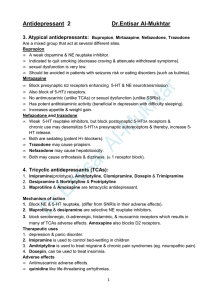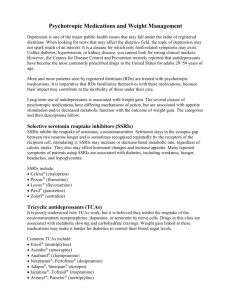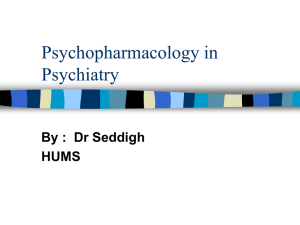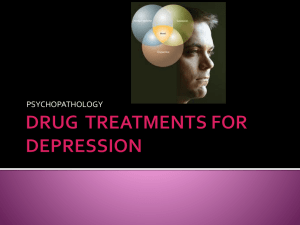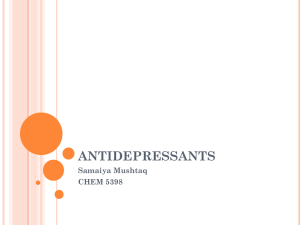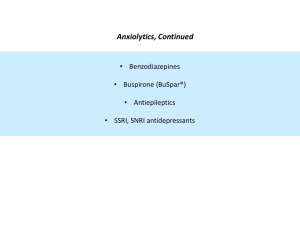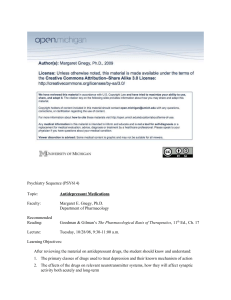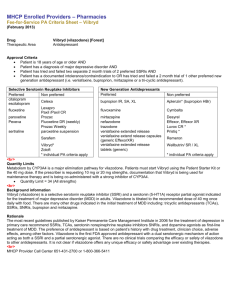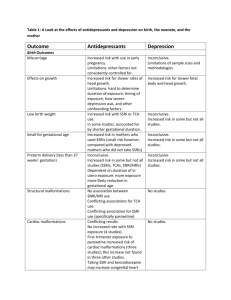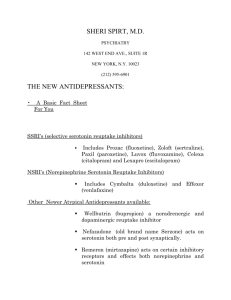antidepressant
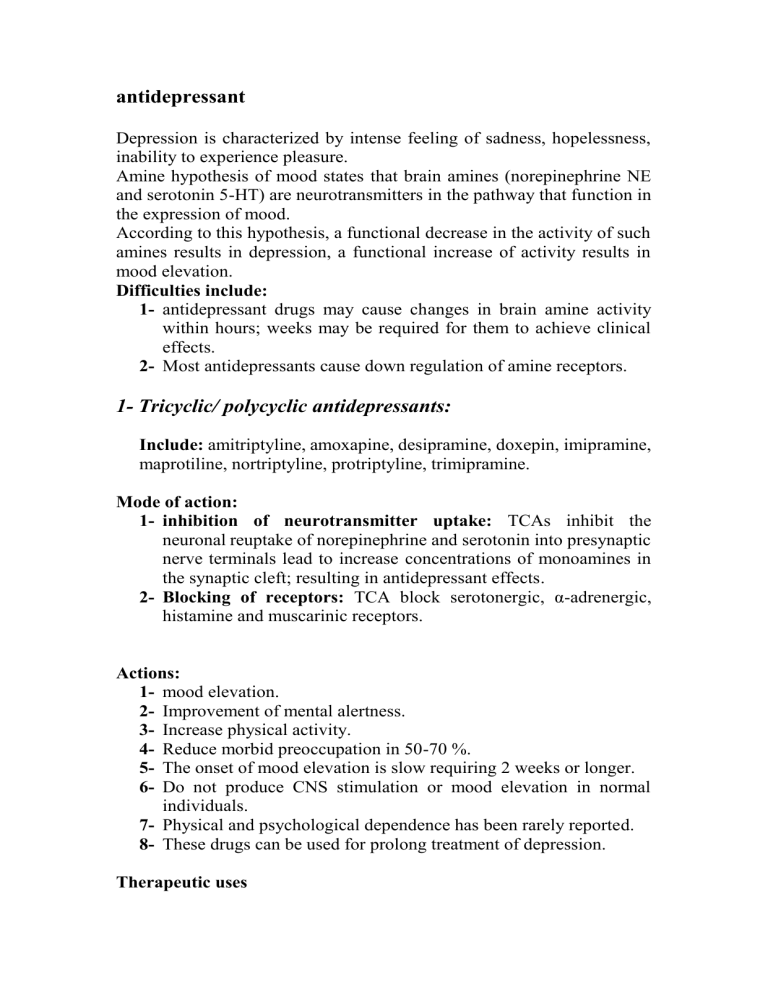
antidepressant
Depression is characterized by intense feeling of sadness, hopelessness, inability to experience pleasure.
Amine hypothesis of mood states that brain amines (norepinephrine NE and serotonin 5-HT) are neurotransmitters in the pathway that function in the expression of mood.
According to this hypothesis, a functional decrease in the activity of such amines results in depression, a functional increase of activity results in mood elevation.
Difficulties include:
1antidepressant drugs may cause changes in brain amine activity within hours; weeks may be required for them to achieve clinical effects.
2Most antidepressants cause down regulation of amine receptors.
1- Tricyclic/ polycyclic antidepressants:
Include: amitriptyline, amoxapine, desipramine, doxepin, imipramine, maprotiline, nortriptyline, protriptyline, trimipramine.
Mode of action:
1inhibition of neurotransmitter uptake: TCAs inhibit the neuronal reuptake of norepinephrine and serotonin into presynaptic nerve terminals lead to increase concentrations of monoamines in the synaptic cleft; resulting in antidepressant effects.
2Blocking of receptors: TCA block serotonergic, α-adrenergic, histamine and muscarinic receptors.
Actions:
1mood elevation.
2Improvement of mental alertness.
3Increase physical activity.
4Reduce morbid preoccupation in 50-70 %.
5The onset of mood elevation is slow requiring 2 weeks or longer.
6Do not produce CNS stimulation or mood elevation in normal individuals.
7Physical and psychological dependence has been rarely reported.
8These drugs can be used for prolong treatment of depression.
Therapeutic uses
1treatment of moderate to sever major depression.
2Panic disorder.
3Imipramine has been used to control bed-wetting in children (older than 6 years) but with caution because of the inducement of cardiac arrhythmias.
4Treatment of migraine headache and chronic pain.
Pharmacokinetics:
TCAs are well absorbed upon oral administration; and because of their lipophilic nature, are widely distributed and readily penetrate into CNS.
Have long half life for e.g. 4-17 hrs for imipramine. The initial period of treatment is typically 4-8 weeks. The dose can be gradually reduced unless relapse occurs. TCAs are metabolized in the liver and excreted in urine.
Adverse effects
1Antimuscarinic effects: blockade of Ach receptors leads to blurred vision, constipation, aggravation of glaucoma and epilepsy.
2Cardiovascular: increased catecgolamine activity results in cardiac overstimulation, slowing of atrioventricular conduction.
3Orthostatic hypotension and reflex tachycardia: due to αadrenergic receptors blocking.
4Sedation: during the first several weeks.
5Weight gain and sexual dusfunction.
6Narrow therapeutic index; 5-6 fold the maximal daily dose may be lethal.
2- selective serotonin reuptake inhibitors (SSRI):
Include: citalopram, escitalopram, fluoxetine, fluvoxamine, paroxetine, sertraline, nefazodone, trazodone and venlafaxine.
SSRIs are a group of chemically diverse antidepressant drugs that specifically inhibit serotonin reuptake, leading to increased concentration of neurotransmitter in the synaptic cleft.
Compared with TCA, SSRIs have little blocking activity to the dopamine transporter; muscarinic; α-adrenergic and histaminic H
1 receptors so associated with less side effects than TCAs.
Therapeutic uses
1depression.
2Absessive- compulsive disorder (fluvoxamine is effective).
3Pppanic disorder.
4Generalized anxiety disorder; social anxiety disorder.
5Premenstrual syndrome.
6Bulimia nervosa (fluoxetine).
Pharmacokinetics
All of SSRIs are well absorbed after oral administration. Food increases absorption of sertraline only. Plasma half life range between 16-36 hrs fluoxetine has longer half life (50 hrs) and available as a sustained release preparation allowing once weekly dosing. Fluoxetine and paroxetine are potent inhibitors of a hepatic cytochrome p
450
responsible for the elimination of TCA drugs, neuroleptic, some antiarrhythmic, βadrenergic antagonist drugs.
Adverse effects
1nausea, vomiting, diarrhea.
2Headacke, anxiety.
3Sweating.
4Weakness and fatigue.
5Sexual dysfunction.
6Changes in weight.
7Sleep disturbances.
3Monoamine oxidase inhibitors(MAOIs)
Monoamine oxidase (MAO) is a mitochondrial enzyme found in nerve and other tissues such as gut and liver. In the neuron MAO functions as a safety valve that deaminate and inactivate any excess neurotransmitter molecules ( norepinephrine, dopamine and serotonin).
MAOIs may reversibly or irreversibly inactivate the enzyme, permitting neurotransmitter molecules to escape degradation and therefore to accumulate within the presynaptic neuron and leak into the synaptic space.
MAOIs include: phenelzine, isocarboxazide and tranylcypromine.
Yses of MAOIs is now limited because of dietary restriction required in patients taking MAOIs.
Mechanism of action
Most MAOIs such as isocarboxazide and phenelzine form stable complexes with MAO enzyme causing irreversible inactivation. This results in increased stores of norepinephrine, serotonin and dopamine within the neuron and subsequent diffusion of excess neurotransmitter into synaptic cleft.
Actions
Although MAO is fully inhibited after several days of treatment, the antidepressant action of MAOI like that of TCA and SSRIs is delayed several weeks.
Phenelzine and tranycypromine have mild amphetamine like stimulant effect.
Therapeutic use
1used in depressed patients who are unresponsive or allergic to
TCA or who are experience strong anxiety.
2Patients with low psychomotor activity may benefit from the stimulant properties of MAOIs.
3Treatment of phobic states.
4Atypical depression.
Pharmacokinetics
These drugs are well absorbed orally, but antidepressant effects requires at least 2-4 weeks of treatment. When switching antidepressant agent a minimum of 2 weeks of delay must be allowed after termination of MAOI therapy and initiation another antidepressant. MAOIs are metabolized and excreted rapidly in urine.
Adverse effects
1sever and often unpredictable side effects limit the widespread use of MAOIs. For example tyramine containing food such as aged cheese, chicken liver, beer and red wines, is nortmally activated by
MAO in the gut. Tyramine causes the release of large amounts of stored catecholamines from nerve terminals resulting in headache, tachycardia, nausea, hypertension, cardiac arrhythmia; patients must be educated to avoid tyramine containing food.
2Other side effects are drowsiness, orthostatic hypotension, blurred vision, dry mouth, dysurea and constipation. MAOIs and SSRIs should not be coadministered due to the risk of life threatening
"serotonin syndrome ".
